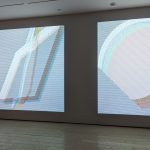Casey Reas: MicroImage
Artist(s):
Title:
- MicroImage
Exhibition:
Collection:
Creation Year:
- 2004
Size:
- 30 inches x 120 inches
Category:
Artist Statement:
Microlmage explores the phenomenon of emergence through the medium of software. It is a microworld where thousands of autonomous software organisms and a minimal environment create a software ecosystem. As the environment changes, the organisms aggregate and disperse according to their programmed behavior. They are tightly coupled to the environment, and slight changes in the environment create macroscopic changes in the ecosystem. A field of undulating form emerges from the interactions between the environment and the organisms. The visual qualities of Microlmage were selected to make the dynamic structure highly visible. The code specifies the behavior of each organism by defining the rules for how it responds to its simulated environment. Each organism was given the most minimal visual form: a point. To differentiate the various categories of organisms, each type was assigned a distinct color. Aggressive organisms were assigned warm colors, and passive organisms were assigned cool colors. As a further refinement, the values of the colors were modified to change in relation to the speed of the organism. When the organism is moving at its maximum speed, it is represented with its pure hue, but as it slows down, the hue changes along a gradient until it reaches black. Each organism is displayed as a line connecting its current position and its previous 20 positions. Through this visualization, the movement of each organism is seen in both static images and kinematic representations. The linear notation allows the viewer to discern the past and present motion of the organism.
Technical Information:
The core of the Microlmage software was written in one day. The current version of the software has developed through a gradual evolution. While the base algorithm controlling the movement was constructed in a rational way, subsequent developments were the result of aesthetic judgments constructed through many months of interacting with the software. Through directly manipulating the code, hundreds of quick iterations were created, and changes were implemented
based on analyzing the responsive structures. This process
was more similar to intuitive sketching than rational calculation.
Other Information:
Similar artworks are also available in the Victoria and Albert Museum. (1 of 3 similar prints, 2002)
http://collections.vam.ac.uk/item/O1193783/microimage-print-reas-casey/







